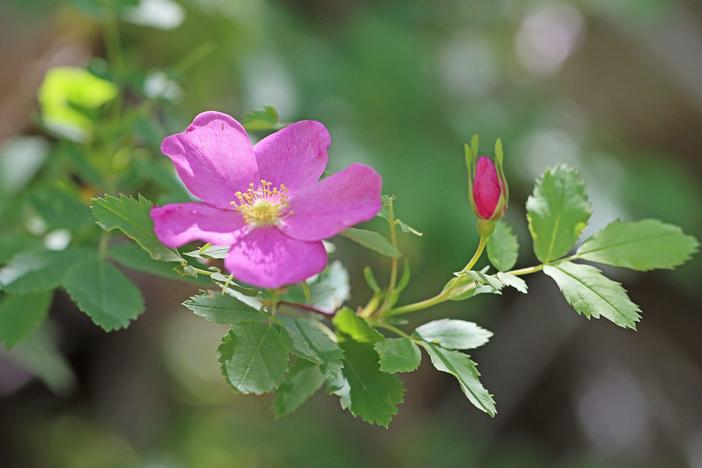Woods’ Rose
(Rosa woodsii var. ultramontana)
Woods’ Rose (Rosa woodsii var. ultramontana)
/
/

Andrey Zharkikh
CC BY 2.0
Image By:
Andrey Zharkikh
Recorded By:
Copyright:
CC BY 2.0
Copyright Notice:
Photo by: Andrey Zharkikh | License Type: CC BY 2.0 | License URL: https://creativecommons.org/licenses/by/2.0/ | Uploader: AndreyZharkikh | Publisher: Flickr




















Estimated Native Range
Summary
Rosa woodsii var. ultramontana, commonly known as Woods’ Rose, is a deciduous subshrub native to a variety of habitats including open woodlands, forest edges, and riparian zones, primarily in the Western United States. It typically grows to a height of 3-6 feet (0.9-1.8 meters) and a width of 5-6 feet (1.5-1.8 meters). This species forms dense thickets with arching stems and is covered with prickles. The foliage is pinnately compound with leaflets that are oval and toothed. Woods’ Rose is notable for its showy, fragrant pink flowers that bloom in early summer, followed by red-orange, spherical to pear-shaped hips that persist into winter and provide food for wildlife.
Woods’ Rose is valued for its hardiness and low maintenance, making it suitable for naturalistic plantings, wildlife gardens, and erosion control. It is also used for restoration projects and as a rootstock for grafting cultivated roses. This rose prefers full sun to part shade and adapts to a range of soil types, though it thrives in well-drained soils. While generally disease-resistant, it can be susceptible to rust and powdery mildew. Gardeners should be aware that it can spread by suckers, potentially becoming invasive in some conditions.CC BY-SA 4.0
Woods’ Rose is valued for its hardiness and low maintenance, making it suitable for naturalistic plantings, wildlife gardens, and erosion control. It is also used for restoration projects and as a rootstock for grafting cultivated roses. This rose prefers full sun to part shade and adapts to a range of soil types, though it thrives in well-drained soils. While generally disease-resistant, it can be susceptible to rust and powdery mildew. Gardeners should be aware that it can spread by suckers, potentially becoming invasive in some conditions.CC BY-SA 4.0
Plant Description
- Plant Type: Shrub
- Height: 3-6 feet
- Width: 5-6 feet
- Growth Rate: Moderate
- Flower Color: Pink
- Flowering Season: Summer
- Leaf Retention: Deciduous
Growth Requirements
- Sun: Full Sun, Part Shade
- Water: Medium
- Drainage: Medium
Common Uses
Bee Garden, Bird Garden, Butterfly Garden, Fragrant, Groundcover, Low Maintenance, Showy Flowers, Street Planting
Natural Habitat
Open woodlands, forest edges, and riparian zones
Other Names
Common Names: Wood Rose
Scientific Names: , Rosa woodsii var. ultramontana, Rosa woodsii subsp. ultramontana, Rosa ultramontana, Rosa grosseserrata, Rosa californica var. ultramontana, Rosa salictorum, Rosa pyrifera, Rosa covillei, Rosa rotundata
GBIF Accepted Name: Rosa woodsii var. ultramontana (S.Watson) Jeps.